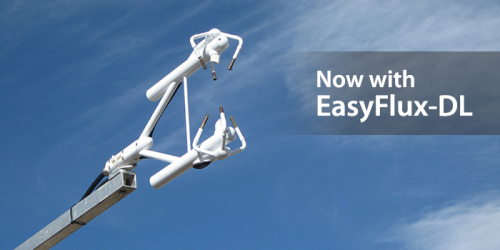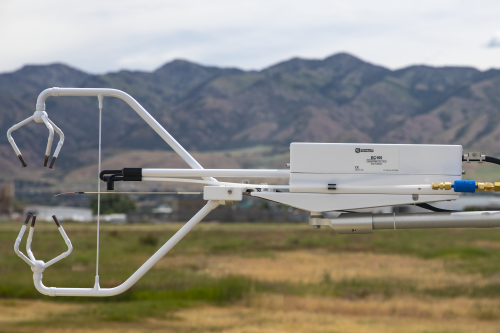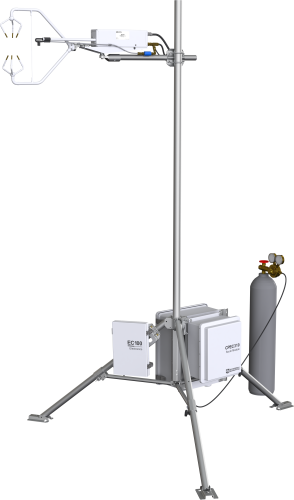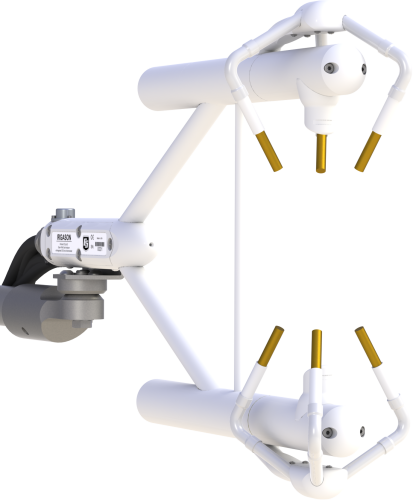Gas Flux and Turbulence / Gas Flux and Turbulence
More Details about Our Gas Flux and Turbulence Systems
Add energy balance or biomet sensors, such as:
| HMP155A-L Temperature and Relative Humidity Probe |
 |
| NR-LITE2-L Net Radiometer |
 |
| NR01-L 4-Component Net Radiometer |
 |
| CNR4-L 4-Component Net Radiometer |
 |
| TCAV-L Averaging Soil Thermocouple Probe |
 |
| CS616 Water Content Reflectometer |
 |
| CS650 30 cm Soil Water Content Reflectometer |
 |
| CS655-L 12 cm Soil Water Content Reflectometer |
|
| HFP01-L Soil Heat Flux Plate |
 |
| HFP01SC-L Self-Calibrating Soil Heat Flux Plate |
 |
Case Studies
Florida: Sampling the Atmospheric Boundary Layer
Understanding the spatial variability of the Earth’s atmospheric boundary layer—including the surface layer near the......read more
Understanding the spatial variability of the Earth’s atmospheric boundary layer—including the surface layer near the......read more
United Kingdom: Pioneering Research in Carbon Sequestration
Overview In the fight against climate change, innovative solutions are emerging to address the global challenge......read more
Overview In the fight against climate change, innovative solutions are emerging to address the global challenge......read more
Utah: Flux Stations
The Utah Geological Survey, supported by the Utah Division of Water Rights, has constructed a......read more
The Utah Geological Survey, supported by the Utah Division of Water Rights, has constructed a......read more
China: Flux Cooperation
This case study discusses the integration of CPEC310 and AP200 systems to explore the theories......read more
This case study discusses the integration of CPEC310 and AP200 systems to explore the theories......read more
Australia: Ecological Research
The Warra long-term ecological research (LTER) site located in Southwestern Tasmania was founded in 1995......read more
The Warra long-term ecological research (LTER) site located in Southwestern Tasmania was founded in 1995......read more
Australia: Ecological Research
The Warra long-term ecological research (LTER) site located in Southwestern Tasmania was founded in 1995......read more
The Warra long-term ecological research (LTER) site located in Southwestern Tasmania was founded in 1995......read more
India: Rice-Field Greenhouse Gases
The cultivation of rice—the staple food for India, as well as for approximately half the......read more
The cultivation of rice—the staple food for India, as well as for approximately half the......read more
British Columbia: Forest Carbon Sequestration
Forest habitats contribute more than any other terrestrial biome to carbon cycles and processes. It......read more
Forest habitats contribute more than any other terrestrial biome to carbon cycles and processes. It......read more
Documents
Brochures
- EC150 CO2 and H2O Open-Path Gas Analyzer with Optional 3D Sonic Anemometer
- AP200 CO2/H2O Atmospheric Profile System
- CSAT3B 3-D Sonic Anemometer with Integrated Electronics
- EasyFlux DL Eddy-Covariance Data Logger Program
- EasyFlux PC Eddy Covariance Post Processing PC Software
- EasyFlux Web Eddy-Covariance Browser-Based Software
Technical Papers
Articles and Press Releases
Newsletter Articles
Press Releases
- Campbell Scientific Announces Appointment of General Counsel 05-10-2017
- Innovative Carbon Monitoring Sensor Issued a U.S. Patent: Campbell Scientific’s IRGASON receives U.S. patent 29-04-2013
- New Open-Path Analyzer for Eddy-Covariance Flux Measurements 25-06-2010
- New Closed-Path Gas Analyzer for Eddy-Covariance Flux Measurements 25-06-2010
- Faster and Flexible: Campbell Scientific’s CR3000 Micrologger® 01-10-2005
Privacy Policy Update
We've updated our privacy policy. Learn More
Customise a System
In addition to our standard systems available, many of the systems we provide are customised. Tell us what you need, and we’ll help you configure a system that meets your exact needs.











